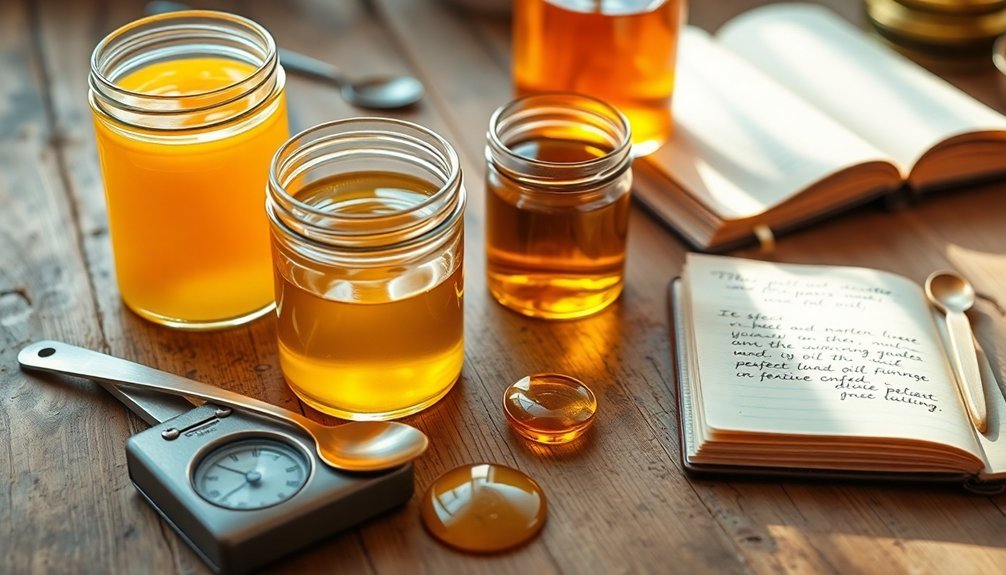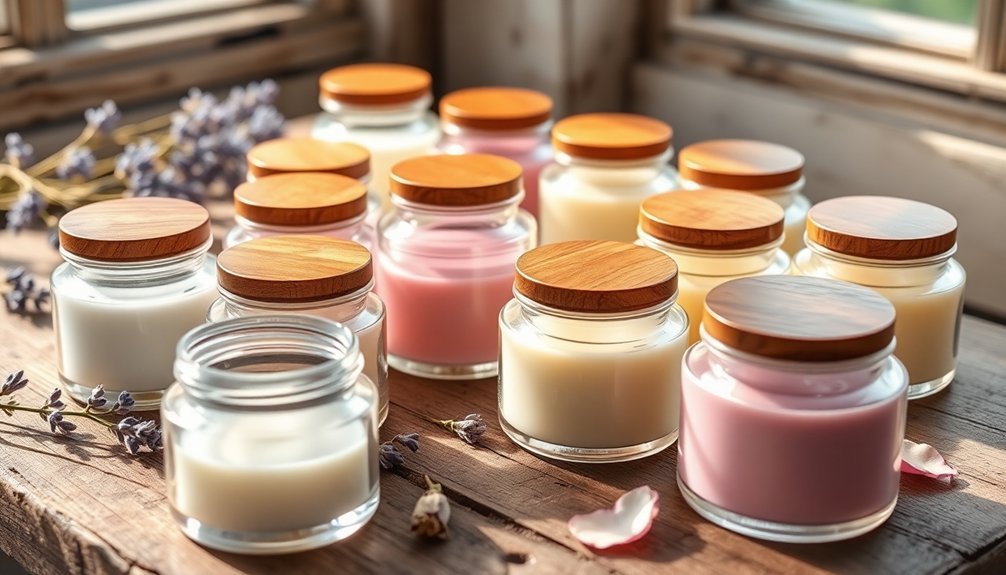Start your DIY solid perfume journey by mastering the basic 1:1 ratio of beeswax to carrier oil, adjusting as needed for your climate. You'll want to follow the 2:1:1 essential oil blending rule: two parts base notes (like sandalwood), one part middle notes (like geranium), and one part top notes (like bergamot). Always store your creation in a cool, dark place using airtight containers. These fundamentals will set you up for countless creative scent combinations.
Getting the Perfect Wax-to-Oil Ratio

While creating solid perfume may seem intimidating at first, achieving the right wax-to-oil ratio is the key to success.
Start with equal parts beeswax and carrier oil – this basic 1:1 ratio serves as an excellent foundation for beginners.
Equal parts beeswax and carrier oil create the perfect starting point for novice perfume makers exploring solid fragrances.
You'll need to take into account your climate when deciding on proportions. If you're in a warmer region, increase the wax content to prevent melting. For cooler areas, you can use less wax.
Common ratios range from 2:1 to 4:1 oil-to-wax, depending on your desired consistency. If your mixture turns out too firm, simply add more oil. Too soft? Add more wax. For the liquid oil component, jojoba oil works exceptionally well due to its neutral scent profile.
Mastering Essential Oil Blending Basics
Creating a solid perfume's scent profile begins once you've mastered the wax-to-oil ratio. The key to successful blending lies in understanding the three essential oil categories: base, middle, and top notes.
You'll want to follow the 2:1:1 ratio – two parts base notes, one part middle notes, and one part top notes.
Start with rich base notes like patchouli or sandalwood, which provide staying power. Add complexity with middle notes such as geranium or cardamom. Finally, incorporate bright top notes like bergamot or lemon. Consider using orange essential oil instead of lemon, as it offers an energizing and uplifting effect.
For a 4-teaspoon solid perfume base, you'll need about 40-45 drops of essential oils total. Remember to test your blend as you go, and don't rush the process.
Your signature scent should reflect your personal preferences while maintaining a balanced profile.
Proper Storage and Container Selection

Three key factors determine how well your solid perfume maintains its quality: proper storage conditions, container selection, and handling practices.
Store your solid perfume in a cool, dark place away from direct sunlight and heat sources. Temperature fluctuations and light exposure can degrade essential oils and affect consistency.
For containers, opt for small metal tins or dark glass jars with airtight seals – they're perfect for travel and protect against light damage. One-ounce containers work well for daily use. Lip balm tubes provide an easy alternative application method.
To extend shelf life, keep your perfume away from moisture and always close containers tightly after use.
Using quality ingredients like jojoba oil and maintaining consistent wax-to-oil ratios in your recipes will help guarantee stability. Making smaller batches prevents waste and keeps your perfume fresh longer.
Frequently Asked Questions
How Long Does Homemade Solid Perfume Typically Last Before the Scent Fades?
Your homemade solid perfume's scent will typically last 3-6 months before fading. However, you'll get longer wear if you're storing it properly in a cool, dark place with a tight-sealed container.
Can I Melt and Reuse Commercial Perfumes in My Solid Perfume Recipe?
Yes, you can melt and reuse commercial perfumes in solid perfume recipes. Just mix your liquid perfume with melted beeswax and carrier oil, but be aware that heat might slightly affect the fragrance's intensity.
Why Does My Solid Perfume Develop a Grainy Texture After Cooling?
Your solid perfume turns grainy when it cools too slowly or unevenly. You'll prevent this by quickly cooling the mixture in the fridge and ensuring you've thoroughly melted all ingredients together.
What Natural Colorants Can I Safely Add to My Solid Perfume?
You can safely use mica for shimmer, iron oxide for rich colors, or natural clays for muted tones. Start with small amounts and verify they're cosmetic-grade. Don't use food dyes or non-approved colorants.
How Can I Clean My Tools After Making Solid Perfume?
Clean your tools immediately with isopropyl alcohol and warm soapy water. You'll want to soak stubborn wax residue, use paper towels to wipe, and run dishwasher-safe items through a sanitizing cycle.





Leave a Reply